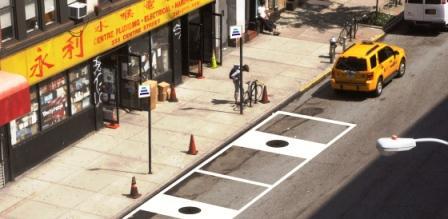Wireless EV chargers, designed by HEVO Power, have hit NYC streets. Park over one, and your electric vehicle could reach a near-full charge in about an hour.
October 25, 2013
Wireless car charging will take a small step forward early next year as New York University installs roadway-based magnetic resonance chargers that look like manhole covers.
The chargers, weighing approximately 50 pounds apiece, will be embedded in the pavement and sit flush with the roadway. Electric vehicles that park above them will be able to recharge at power levels as high as 10 kW, meaning that a large plug-in hybrid battery could theoretically be refilled from 20 percent to 80 percent in as little as an hour.
”What we’re making here is the fueling station of the future,” Steven Monks, chief operating officer of HEVO Power, told Design News. “Drivers don’t want to get out of their cars to charge up when it’s raining. And many aren’t comfortable holding a 240V line. This works better with their expectations of electric vehicle technology.”

HEVO Power predicts that wireless charging stations (in the black circles that look like manhole covers) will enable electric delivery trucks to recharge in “green loading zones.”
(Source: HEVO Power)
The Polytechnic Institute of New York University will use the devices to recharge the school’s electric security vehicles. The charger package consists of transmitter and receiver units, including coils, capacitor banks, inverters, converters, and printed circuit boards. Transmitters will be located in glass composite containers in the roadway, while receiver units will be housed onboard the electric vehicles. The devices will recharge the batteries of parked EVs across an air gap via a magnetic field.
HEVO Power, a start-up launched in 2011, designed the chargers to be convenient and to offer the shortest possible charge times. Maximum power is 10 kW, but that figure varies from vehicle to vehicle. While some vehicles can charge at 10 kW, others operate as low as 1 kW to 2 kW. Charging times will therefore vary widely -- from an hour to many hours -- depending upon the operating power and the size of the vehicle’s battery.
”Our target was 10 kW,” Monks told us. “To have a really functional system, you’ve got to deliver at that rate.”
Executives at HEVO Power said they expect to install more of the units around New York City. City officials like the idea of wireless charging, Monks told us. “City representatives thought that plug-in stations would not be tenable,” he said. “In terms of liability, you have a plug-in cord dangling on the sidewalk. You have kiosks that clutter the area. And the units are subject to vandalism.” Wireless charging systems have none of those issues, he said.
HEVO also expects to sell the technology to commercial fleets for so-called “green loading zones.” There, delivery trucks could recharge during loading and unloading, theoretically packing as much as 10 kWh into the battery during a one-hour stop.
Although the chargers at New York University will look like manhole covers, that won’t always be the case, Monks said. “They could be circular or rectangular or whatever the application calls for,” he told us. “The shape will ultimately be driven by the needs of the customer.”
Related posts:
{doclink 268362}
{doclink 268127}
{doclink 267926}
{doclink 267878}
{doclink 267833}
{doclink 267339}
{doclink 267317}
{doclink 266142}
{doclink 266450}
{doclink 266188}
{doclink 266061}
{doclink 265790}
{doclink 265529}
{doclink 265157}
{doclink 264712}
{doclink 263072}
{doclink 261927}
{doclink 261782}
{doclink 261236}
{doclink 260529}
{doclink 259550}
{doclink 258495}
{doclink 258113}
{doclink 257628}
{doclink 256966}
{doclink 255754}
{doclink 255564}
{doclink 255380}
{doclink 255191}
{doclink 255091}
{doclink 254150}
{doclink 252881}
{doclink 251534}
{doclink 251483}
{doclink 250517}
{doclink 250256}
{doclink 249928}
{doclink 249519}
{doclink 248442}
{doclink 246722}
{doclink 246644}
{doclink 245676}
{doclink 245442}
{doclink 244906}
{doclink 244832}
{doclink 244669}
{doclink 242498}
{doclink 242424}
{doclink 242108}
{doclink 241552}
{doclink 241175}
{doclink 240962}
{doclink 240363}
{doclink 240303}
{doclink 239766}
{doclink 238863}
{doclink 237768}
{doclink 237698}
{doclink 237534}
{doclink 237329}
{doclink 237015}
{doclink 236557}
{doclink 235252}
{doclink 235241}
{doclink 235140}
{doclink 234687}
{doclink 234367}
{doclink 234251}
{doclink 233282}
{doclink 233004}
{doclink 229120}
{doclink 228520}
About the Author(s)
You May Also Like



